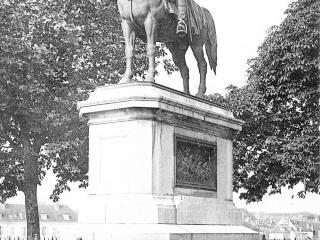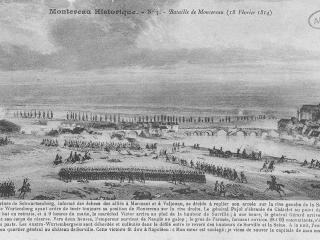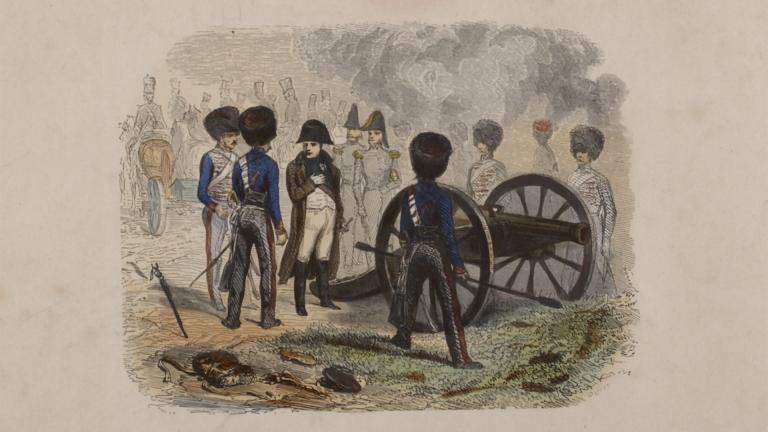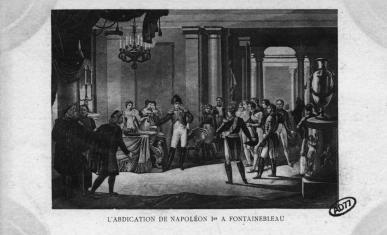February 1814: the campaign in north-east France took place in Seine-et-Marne

Between December 1813 and April 1814, the 6th coalition, formed by Great Britain, Russia, Prussia, some German states of the Confederation of the Rhine and Austria, led a campaign in France against the Napoleonic Empire. The coalition’s plan was the following: the Army of Bohemia, led by Prince Charles-Philippe of Schwarzenberg, would march against Napoleon to allow the Army of Silesia, led by Prince Gebhard Leberecht von Blücher, to take Paris.
Up until 8th February 1814, the allied armies advanced east and south towards Paris. The Napoleonic troops retreated. However, the 6th coalition committed a strategic error by sending the Army of Silesia north of the Marne and the Army of Bohemia south of the Seine. The French went on to win a succession of victories in the Marne (10th-14th February 1814) and in Seine-et-Marne and Aube (15th-26th February 1814).
11thFebruary:The Army of Bohemia, led by the Prince of Schwartzenberg, attacked Moret-sur-Loing but was pushed back south of the Seine.
12th February: The Army of Bohemia crossed the Seine at Bray despite fierce resistance from the French soldiers. It invested the south of the department of Seine-et-Marne with the support of other troops via the Loiret and Yonne rivers.
13th February: While Moret and Nemours held out against the attacks, French troops blew up the bridge at Nogent-sur-Seine (Aube) and withdrew to Provins and Nangis.
14th February: Beginning of the occupation of Montereau by foreign troops. This strategic passage at the confluence of the Yonne and Seine rivers lead the way to Melun and Paris.
15th February: Napoleon went to Meaux with the Guard.
16thFebruary:After having put the Army of Silesia in disorder on the border of the Aisne, the Marne and the north of Seine-et-Marne, Napoleon set up his large headquarters in Guignes (Seine-et-Marne) to lead an offensive against the Army of Bohemia in the south of the department. The opposing armies’ respective positions were as follows:
- The Prince of Schwarzenberg's plan was to withdraw every military unit engaged on the right bank of the Seine towards Troyes, by blowing up the bridges, in order to join the Army of Silesia and concentrate the two invading armies so as to march together towards Paris.
- Napoleon's plan was to attack using the troops engaged on the road to Paris in order to seize the bridges of Montereau and Bray as quickly as possible and force the Army of Bohemia into battle before the Army of Silesia was reconstituted and could assist them.
Part of the coalition troops retreated in the morning to Provins and Nogent. Fighting took place in Mormant, partly under Napoleon's command, then in Villeneuve-le-Comte, Grande-Maison, and their surroundings. The coalition troops were pushed back towards Montereau, Nangis, Grand-Puits and Donnemarie-Dontilly.
However, between Bailly and Nangis and at Gurcy-le-Châtel, the French troops succeeded in stopping their retreat several times, causing several battalions to flee. The marshes of Encoeur also made it difficult to retreat to Grand-Puits and accelerated the destruction of enemy troops.
Napoleon's army progressed in two columns, one towards Donnemarie-Dontilly (bivouac in Montigny-Lencoup, Salins et Savins, Maison-Rouge), the other towards Montereau (bivouac in Valence-en-Brie). Napoleon was in the Château de Nangis. Leaving Provins and Donnemarie-Dontilly, the coalition troops withdrew towards Nogent, reached Bray and occupied the villages on the right bank next to the bridge to prevent the French from entering.
Despite the day's moves, Napoleon did not take possession of the bridges of Bray and Nogent. Furthermore, he learned rather late that the Montereau bridge was still in the hands of some 18,000 enemy soldiers, led by the Prince of Württemberg, and based in Montereau, from the hamlet of Les Ormeaux (now the district of Montereau) to Forges.

French troops crossed the territory between Montereau and Bray, freed Fontainebleau and Moret-sur-Loing, pushing back foreign troops behind the Loing canal.
At the same time, after attempting to take the Surville plateau (Montereau) several times, unsuccessfully, the French army managed to control the enemy fire under the command of General Gérard and then Napoleon. Driven out of Valence-en-Brie towards Montereau, the enemy troops disorganised and tried with great difficulty to retreat across the Montereau bridge. The obstruction of the passageway also hindered intervention from their backup based on the left bank. Although the bridge resisted an explosion which was instructed to prevent the French cavalry from crossing over, the inhabitants supported the imperial army by throwing tiles and furniture at the enemy through the windows.
At the end of the battle, the coalition troops continued their retreat towards Trainel and Nogent-sur-Seine. Others reached Villenauxe and Courtavant or joined the left bank between Bray and Nogent. In the days that followed, Napoleon left the Château de Surville and conducted his troops towards Sens, Bray and Donnemarie-en-Montois.
Driven out of Seine-et-Marne, defeated and disunited, the coalition armies regained the upper hand from 27thFebruary 1814 (victory in Bar-sur-Aube) and then they reached Paris on 30thMarch 1814. A few days later, on 11thApril 1814, Napoleon abdicated in Fontainebleau.
At the end of the Battle of Montereau, there were:
- On the coalition side: 1,470 wounded, 6,000 dead, 3,000 prisoners of the Army of Bohemia, including one of Prince Schwartzenberg's generals.
- On the French side: 370 wounded (including 4 inhabitants of Montereau who were hit by a French artillery shell in their home).
Some bodies were thrown into the Seine, others were buried by the communes’ inhabitants downstream of the Seine. It wasn't until 20th May 1814 that the mayor of Montereau called upon a commissioner appointed to organise the burial of dead bodies and horses. The troops passing by and fighting caused material damage (loss of livestock, fodder and food, house fires and so on) in Montereau and the surrounding communes, in particular Varennes, La Brosse-Montceaux, La Tombe, Cannes, Forges and La Grande Paroisse.
Bibliography / Sources:
- Loubet Ludovic, La bataille de Montereau, mémoire de maîtrise, Université Paris I Panthéon-Sorbonne (The battle of Montereau, Master's thesis, University of Paris I Panthéon-Sorbonne), 1999-2000 (AD77, 100J964) -
- AZ9086, La Campagne de France : la bataille de Montereau, 18 février 1814 (Campaign in north-east France: the battle of Montereau, 18th February 1814), Jacques Bienvenu - Montereau, 1964.
- Les combats de Mormant, de Villeneuve-le-Comte et de Montereau (17 et 18 février 1814) (The battles of Mormant, Villeneuve-le-Comte and Montereau (17th and 18th February 1814)), ed. 1889, 35 p, in-8, Bibliothèque nationale de France, Philosophy, History, Human Sciences Department, 8-LH5-1296, record no. FRBNF34085967.


